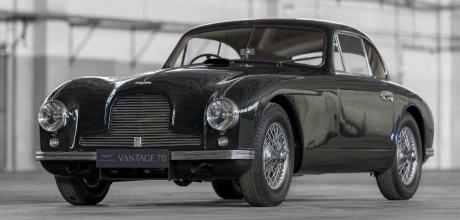1950 Aston Martin DB2 Vantage
Although still a current model name, Vantage goes back to theFifties. We look at the history of the first that was based on the DB2.
ADVANTAGE ASTON HISTORY DB2 VANTAGE
The first Aston to use the Vantage name was the DB2 from 1950. We explore its history and significance
WORDS: PAUL WALTON

Just as AMG has come to define faster versions of Mercedes-Benz as the letter M does for BMW, Vantage is the equivalent for Aston Martin. But while the other two are reasonably new monikers, Vantage goes all the way back to 1950 and the first to feature it, the DB2.
Even before the car made its official debut at the 1950 New York Motor Show in April, the next three cars that followed what would be the eventual show car on the production line were diverted to Aston’s embryonic Competitions department to be prepared for the toughest test in motor racing; the Le Mans 24 Hours race in France. The 2.6-litre Lagonda-designed engine of all three cars – later registered VMF 63, VMF 64 and VMF 65 – were fitted with larger SU HV6 carburettors and given a higher 8.16:1 compression ratio which resulted in 125bhp, a 20bhp increase over the standard version. They also featured a larger 32-gallon fuel tank, larger battery, quick-action fuel filler caps that were flush with the roof and another flap in the bonnet for a one-gallon oil reserve.
Despite little testing, the cars fared well in this notoriously tough event with two of the three finishing fifth and sixth, securing Aston Martin first and second in the 3.0-litre class.
“The DB2 was reckoned to be the fi nest sports car made in Europe at the time,” said former Aston Martin designer and the man responsible for the model, Claude Hill, in Geoff Courtney’s 1978 book, The Power Behind Aston Martin. “Its chassis gave stiff ness, rigidity, comfort and cornering power – I regard it as the pinnacle of what I did.” In the November of the same year, this performance version of the 2.6 engine became an option for the DB2. Christened Vantage, it originally wasn’t a model name like it is today but applied to the 125bhp straight-six only. With no badging to set them apart, cars with the Vantage engine were indistinguishable from standard models.
Although the Vantage programme was the work of several engineers, a technical paper on valve timing tests stored in the Aston Martin Heritage Trust archive shows that the renowned racing car designer, Robert Eberan von Eberhorst, oversaw the project. Originally famous for his early work with the Auto Union Type D in the Thirties, he moved to Aston Martin in 1950, later designing the Aston Martin DB3 and DB3S. Due to its improved speed and excellent handling abilities, the motoring magazines of the day were impressed by the new DB2. “In the acceleration through the gears, there may be cars which, handled with expertise, can keep level with the Aston Martin up to 30mph,” wrote The Motor magazine in a 1950 test of one of the 1950 Le Mans cars, VMF 63, “but there are very few which can match it at the higher speeds.”
Despite the Vantage engine making the already expensive DB2 more so, it proved to be reasonably popular with a little under 250 of the 411 DB2s produced having the augmented engine. The fact that one finished third overall at the 1951 Le Mans 24 Hours race, as well as winning its class in the following year’s Mille Miglia, further rubberstamped its potential. Although Aston had been around since 1913, it could be argued its status as a manufacturer of high-performance sports cars started with the DB2 Vantage since it set the tone for most of the future models.
Yet despite the positive impact the Vantage engine had on both the DB2’s sales and Aston Martin’s image, it would take until the end of the decade before there was another, this time based on the DB4 in 1958. From that moment on, the name became commonly associated with faster versions of Aston’s cars, the exception being the 1972 Vantage. An update of the 4.0-litre DBS, it was the least powerful car in the company’s range. The V8 Vantage from 1977 returned the name to its rightful place as Aston’s high-performance model and was later used with both the Virage and DB7. In 2004 it became – as it still is – a model name in its own right once again, this time for a new compact two-seater sports car. Since it’s thought more than a third of all Aston Martins have been built to Vantage spec, it’s clearly been a fundamental part of the company’s postwar success. But none of it would have been possible without the success both on and off the track of the first, the DB2 Vantage.


